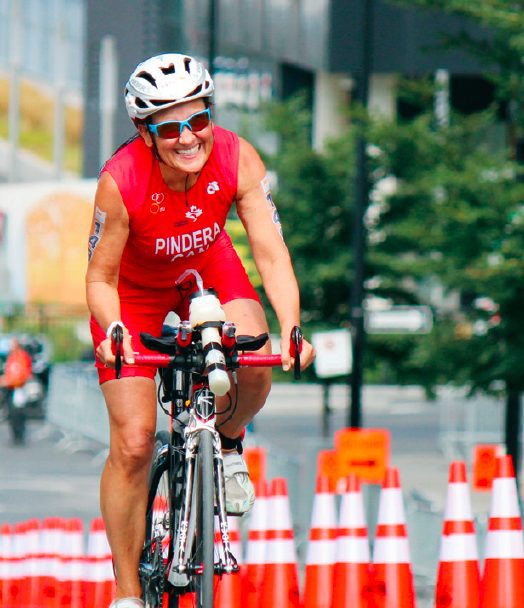Time to hit the gym? Why triathletes shouldn’t neglect strength and conditioning

— By Loreen Pindera
I was excited to participate in the first edition of the Montreal ITU World Cup last August. No matter that the race came just a week after the Quebec long-distance provincial championship in Magog – a challenging, hilly course that left my legs feeling like rubber for days.
The Montreal International Triathlon, at the city’s Old Port, featured some short, steep climbs on the bike circuit, but the run course was flat. Piece of cake after Magog, I figured. I started out fast on that run, figuring my time on the level course was sure to be my seasonal PB. Then, not even at the halfway mark, I felt a strange twinge in my left hip. I ignored it for a few hundred metres. I felt a pop and I heard what sounded like a small explosion on the outside of my hip joint.
The pain took my breath away, knocked me to my knees. I got up, took a few steps, stopped and stretched. I tried walking it out. Somehow, I limped/jogged the last 6 km, hobbled over the finish line and made a beeline for the massage tent. By then the hip was inflamed and when the athletic therapist touched it, I winced.
Ice, rest and four days later my doctor at the McGill Sports Medicine Clinic, Fany Fallenbaum, confirmed the therapist’s diagnosis: acute hip bursitis. The way she described it, in layman’s terms: “That pop you heard was your IT band snapping over the hip joint. The bursa sac that protects the outside of that joint swelled up like a balloon.”
She reckoned that powering my way up those short, steep climbs on the bike course had not helped my already tight hip flexors and tired quads and hamstrings.
After a couple of physiotherapy sessions and some time off running, I was pain-free within weeks. However, the whole episode – my first triathlon injury since I somersaulted my bike in a moment of inattention years ago – was a wake-up call.
At 57, I can no longer assume I can pile up the training miles quickly the way I had over a few weeks in July, and I can’t not take the time to recover between races. And, perhaps more importantly, I can’t fool myself into believing I’m fit and race-ready without incorporating strength and conditioning into my regime.
Ignoring the gym makes me a typical triathlete, says Jason Boivin – a swim coach and a strength and conditioning specialist with McGill University’s varsity swim team as well as with the university’s triathlon club.
“Especially in triathlon, so many people get injured all the time,” said Boivin. “People get injured, and they don’t necessarily know how to fix it. They stop training, and they get better. They start training again, and the injury comes back.”
In other words, whatever imbalance caused that injury in the first place is still there.
“So you have to address it through strength and conditioning,” said Boivin. With his own athletes he does what he calls a “movement screening,” looking for poor form and muscular weaknesses, and then prescribing exercises to correct the imbalance.
If someone comes to him with knee pain from running, for instance, he’ll often conclude it’s caused by poor glute activation – in other words, a weak butt.
“We do exercises that help to get the glutes firing, help stretch the IT band. Suddenly, no knee pain.”
Boivin appreciates that when he tells many age-group triathletes they have to make time to work out in the gym, they beg off: Who has the time for one more training session?
“It ’s hard to integrate strength-andconditioning time into a triathlon training schedule,” he acknowledges. But he suggests the payoffs are huge, if you take a holistic, lifelong approach to fitness.
“What does it mean to be fit?” he asks. As a former elite swimmer, he’s seen high performance athletes that would qualify as “fit,” who put all their time and energy into their sport-specific training.
“They compete super-injured. And then when they’re done their career, they can’t really do anything anymore, because their bodies are wrecked.”
On the other hand, if, like most age-group triathletes, your goal is to live a long, happy life, injury-free, then the way you train and race “has to be sustainable,” Boivin says.
“That is one thing that resistance training will really help you with. It will lengthen your athletic life in a sport like triathlon. It will give you strength in your muscles, in your connective tissue. It will give you positive adaptations in your bone structure, and flexibility and balance.”
With winter approaching, and another triathlon season behind me, it’s tempting to do less, not more, and pull the covers back over my head when I wake up in the dark at 5:30 a.m.
Instead, I’m vowing to learn how to do a proper deadlift and squat, to work on my hip mobility and stability and to do more stretching.
It may mean one less running session in my week or less time on the bike, but Boivin suggests the payoff next year will be worth it.
“That’s going to transfer directly to the run, to the swim, to the bike. When you get tired, or when you go into a cyclic movement like running or cycling, all the muscles are doing their job properly. That way, you don’t get injured.”
I’ll let you know how it goes.
Avid triathlete Loreen Pindera is a producer with CBC radio in Montreal.


